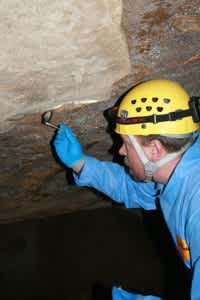Fish and Wildlife Service Awards $1.4 Million in Grants for Research and Management of White-nose Syndrome in Bats
OutdoorHub 04.08.12

The U.S. Fish and Wildlife Service today announced seven grant awards totaling approximately $1.4 million to continue the investigation of white-nose syndrome (WNS) in bats, and to identify ways to manage it. White-nose syndrome has killed more than 5.5 million bats in eastern North America and has spread rapidly across the United States and into Canada since it was first detected in 2006.
“Bats are crucial to our nation’s ecosystems and our economy,” said Service Director Dan Ashe. “These grants provide critical support for the Service and our partners in addressing this unprecedented wildlife crisis.”
The Service is leading a cooperative effort with federal and state agencies, tribes, researchers, universities and other non-government organizations to research and manage the spread of WNS. Funding for grants was provided through Endangered Species Recovery funds. Grant recipients were selected from among 31 grant proposals.
“Research will continue to be essential to the response to white-nose syndrome in North America,” said Dr. Jeremy Coleman, the Service’s national WNS coordinator. “We have made incredible progress in our understanding of the disease and how it affects bats, but we still have work to do. These projects will help further our understanding of WNS and the tools available to manage this devastating disease.”
Funded projects include detailed studies of Geomyces destructans, the fungus demonstrated to cause WNS, including how it interacts with bats and the environment; developing a better understanding of how WNS is transmitted; determining the mechanics of G. destructans infections in bats, including the susceptibility and resistance of bats to the infection; determining how persistent the fungus is in the environment; and identifying and developing non-chemical control options for treatment and prevention of spread of G. destructans.
White-nose syndrome has been confirmed in 19 states and four Canadian provinces at caves and mines where bats hibernate (“hibernacula”), and G. destructans has been detected on bats in one additional state. Winter hibernacula surveys are wrapping up, but the disease is expected to continue to spread in the future.
The Intergovernmental Executive and Steering Committees guiding the WNS response met recently to discuss ongoing implementation of the national WNS plan, international coordination, and the annual WNS Symposium, scheduled for June 2012.
Additional information about WNS, the international disease investigation, and research can be found on the new partner-oriented WNS website,www.WhiteNoseSyndrome.org. The site contains the most up-to-date information and resources from partners in the WNS response, current news, and links to social media.
America’s fish, wildlife, and plant resources belong to all of us, and ensuring the health of imperiled species is a shared responsibility. We are working to actively engage conservation partners and the public in the search for improved and innovative ways to conserve and recover imperiled species. Learn more about the Endangered Species Program at: http://www.fws.gov/endangered/.

